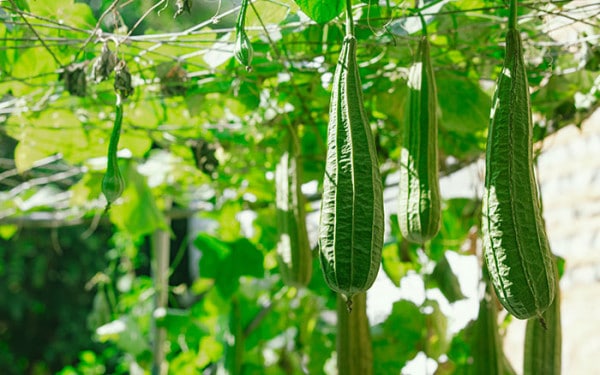In your bathroom you may have a loofah sponge and you’d be forgiven for thinking it comes from the sea. In fact, they are from Luffa plants, and you can grow your own loofah sponges with these handy growing tips.
Get to know
Luffa plants are vine growing plants in the gourd family, the same as cucumbers and pumpkins. Native to the South and Southeast Asia, they do have tropical origins, so you may be surprised to know that they can be grown in UK climates with the right care.
When the fruit dries out and is peeled the fibre is left and this is the part that is used as a sponge.

Practical planting
Check your local garden centre to see if they stock luffa seeds. The packaging will label them as luffa, sponge gourd, Luffa cylindrica or Luffa aegyptiaca. The seeds are small, smooth and dark.
Sow the seeds in March to April in small pots with peat-free compost, burying the seeds at a depth of 2cm and water them in well. Keep the pots indoors and place them in a plastic box positioned in a sunny spot but with the lid left slightly open.
Within 20 days the seeds should have germinated, as long as the temperature stays consistently between 25-30 degrees Celsius.

Growing loofah plants
Once the risk of frost has passed from May, the seedlings with a few leaves can be repotted into larger pots or growbags.
It’s ideal to acclimatise the plants by bringing them outside for the day and taking them back inside for a couple of weeks before planting out. This will get the plants used to the outdoor conditions rather than shocking them by transplanting straight away.
Outdoors, they’ll grow best against a sunny wall with shelter. Bamboo canes, trellis and garden twine can be useful to support the plants that have a climbing, rambling habit.
Water the plants to keep the compost moist, ensuring the compost isn’t wet or waterlogged.

Harvesting
With this care, yellow flowers will bloom, and these will eventually ripen into long green fruits. Leave the fruits on the vine and allow them to dry out before removing them from the plant with secateurs. The dried fruits will be ready for harvest from September onwards.
When the plant has been removed, the tough skin can be removed. With the outer skin gone, the fibrous inside which is the loofah is left. Shake out the seeds and keep them safe in a paper envelope, label them and save them for next growing season.
Before using your new sponge wash it with warm water and let it dry out before using it properly in the bathroom or the kitchen.
This homegrown sponge can be used whole or cut into rounds that can be used for exfoliating or washing up.

Eat the fruits
Of course, you can grow them for the fruits as well as leaving them to mature for the loofahs. The buds, flowers and fruits are all edible, with a summer squash flavour.
For fruits that appear from mid-summer, it’s best to harvest them to eat because they won’t have sufficient time to mature and dry out.
The flowers and young fruit can be eaten raw or cooked into soups, curries and stir-fries.

Growing your own loofah sponges is a great project in the garden for a new challenge. It’ll get the kids excited too, and although it is a long process, they will appreciate the work that goes into it.

Leave A Comment